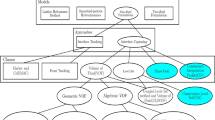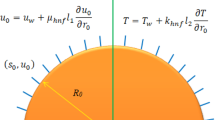Abstract
A three-dimensional transient impulsive flow emanating from an open end of a 165-mm driver section shock tube is investigated numerically in the present study for a shock Mach number of 1.6. Here, the main objective was to find out an appropriate model to simulate the early evolution of the high Mach number transient flows by comparing the flow field obtained from two numerical models with both qualitative and quantitative experimental observations. The 3-D numerical simulations were performed by solving RANS equations using the shear stress transport K-ω model and large eddy simulation of the flow with the help of ANSYS CFX software. The experiments were performed with the simultaneous 2-D and 3-D particle image velocimetry systems and high-resolution smoke flow visualizations. The 2-D PIV results were used for comparing the numerical results obtained on a plane, and the 3-D PIV results were used to compare the azimuthal variations across the vortex ring. It is observed that the velocity field of the transient jet, Kelvin–Helmholtz (K–H) vortices at the trailing jet and the interaction of K–H vortices with the primary vortex ring were resolved well in LES quite similar to the experiments. However, the SST K-ω model resolved only the velocity field of the transient jet in the axial region similar to the experiments and dissipated the K–H vortices at the jet boundary. Though both models resolved the shear layer originated from the triple point, they did not predict the rollup and formation of vortices and their interactions observed in a 24 MP camera. This demands the use of a higher spatial resolution. It is also noticed that a substantial adverse pressure gradient experienced by the vortex ring and trailing jet during the early stage of evolution due to the presence of precursor/incident shock was responsible for the pairing up and merging of the shear layer vortices to form a stronger counter-rotating vortex ring. This adverse gradient also plays a dominant role in the azimuthal expansion (rapid increase in diameter) of the vortex ring.
Graphical abstract













Similar content being viewed by others
References
Arakeri JH, Das D, Krothapalli A, Lourenco L (2004) Vortex ring formation at the open end of a shock tube: a PIV study. Phys Fluids 30:1008–1019
Baird JP (1987) Supersonic vortex rings. Proc R Soc Lond A 409:59–65
Brouillette M, Hebert C (1997) Propagation and interaction of shock generated vortices. Fluid Dyn Res 21:159–169
De S, Murugan T (2011) Numerical simulation of shock tube generated vortex: effect of numerics. I J Comput Fluid Dyn 25:345–354
Dora CL, Murugan T, De S, Das D (2014) Role of slipstream instability in the formation of counter-rotating vortex rings ahead of a compressible vortex ring. J Fluid Mech 753:29–48
Ishii R, Fujimoto H, Hatta N, Umeda Y (1999) Experimental and numerical analysis of circular pulse jets. J Fluid Mech 392:129–153
Kailasanath K (2003) Recent developments in the research on pulse detonation engines. AIAA J 41(2):145–159
Kontis K, An R, Edwards JA (2006) Compressible vortex ring studies with a number of generic body configurations. AIAA J 44:2962–2978
Murugan T (2008) Flow and acoustic characteristics of high Mach number vortex rings during evolution and wall-interaction: an experimental investigation. Ph.D. Thesis, Indian Institute of Technology, Kanpur
Murugan T, Das D (2010) Characteristics of counter-rotating vortex rings formed ahead of a compressible vortex ring. Exp Fluids 49:1247–1261
Murugan T, De S (2012) Numerical visualization of counter rotating vortex ring formation ahead of shock tube generated vortex ring. J Vis 15(2):97–100
Murugan T, De S, Dora CL, Das D (2012) Numerical simulation and PIV study of formation and evolution of compressible vortex ring. Shock Waves 22:69–83
Murugan T, De S, Dora CL, Das D, Premkumar P (2013) A study of the counter rotating vortex rings interacting with the primary vortex ring in shock tube generated flows. Fluid Dyn Res 45:025506
Murugan T, De S, Sreevatsa A, Dutta S (2016a) Numerical simulation of compressible vortex—wall interaction. Shockwaves 26(3):311–326
Murugan T, Deyashi M, Dey S, Rana SC, Chatterjee PK (2016b) A review on recent developments on synthetic jets. Def Sci J 66(5):489–498
Murugan T, De S, Kundu A, Sandhu IPS, Saroha DR (2017) interaction of a shock tube generated blast wave with solid obstacles. In: 11th international high energy materials conference & exhibits, 23–25 November, Pune, India
Phan KC, Stollery JL (1983) The effect of suppressors and muzzle brakes on shock wave strength. In: Proceedings of the 14th international symposium on shock tubes and waves, Springer Berlin, pp 123–129
Rikanati A, Sadot O, Ben-Dor G, Shvarts D, Kuribayashi T, Takayama K (2006) Shock-wave Mach-reflection slip-stream instability: a secondary small-scale turbulent mixing phenomenon. Phys Rev Lett 96:174503
Rubidge S, Skews B (2014) Shear-layer instability in the Mach reflection of shock waves. Shock Waves 24:479–488
Sun M, Takayama K (2003) Vorticity production in shock diffraction. J Fluid Mech 478:237–256
Trefethen LN (1982) Group velocity in finite difference schemes. SIAM Rev 24(2):113–136
Zare-Behtash H, Kontis K, Gongora-Orozcoc N (2008) Experimental investigations of compressible vortex loops. Phy Fluids 20:126105
Zhang H, Chen Z, Li B, Jiang X (2014) The secondary vortex rings of a supersonic under-expanded circular jet with low pressure ratio. Eur J Mech B Fluids 46:172–180
Zhang X, Huang Y, Wang X, Wang W, Tang K, Li H (2016) Turbulent boundary layer separation control using plasma actuator at Reynolds number 2000000. Chin J Aeronaut 29(5):1237–1246
Author information
Authors and Affiliations
Corresponding author
Rights and permissions
About this article
Cite this article
Murugan, T., Dora, C.L., De, S. et al. A comparative three-dimensional study of impulsive flow emanating from a shock tube for shock Mach number 1.6. J Vis 21, 921–934 (2018). https://doi.org/10.1007/s12650-018-0503-5
Received:
Revised:
Accepted:
Published:
Issue Date:
DOI: https://doi.org/10.1007/s12650-018-0503-5




